At Fellowship, Mahaicony, Alfred Richmond was busy working on his farm. He was peeling coconuts to supply to a middleman by midday. His wife, Trudy and son were helping him.
The middleman wanted the biggest and the best quality nuts for exporting. He was paying Richmond $20 each and although the farmer was not satisfied with that price he was very happy that he had gotten a new market.
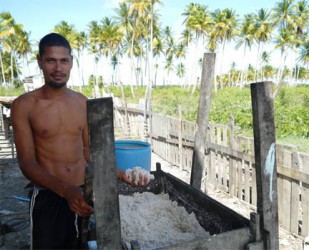
He was distressed though about the decline in his once flourishing business and was praying for it to “pick up.”
A large-scale farmer, he once enjoyed a steady market for coconut oil which he would make with the “rejected” nuts. He sold a large amount of the product at the Stabroek Market but now he is “just selling a little.”
He also sold a small amount in the community but said, “Nobody is coming around now.” In the past, he made one barrel, containing 50 gallons of oil, per day.
Now, he said “the market is not there” and he is barely making 40 gallons per week. The oil is sold at $1,600 per gallon but “the people want it on credit.”
His wife, Trudy told this newspaper that a businessman had recently ordered three barrels of oil. The man, however, did not keep his word about purchasing the oil and the couple was still trying to sell the product off.
Richmond was relieved when he learnt that the Ministry of Agriculture was working to save the coconut industry.
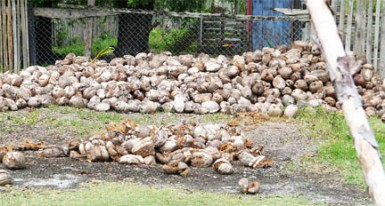
Coconut conference
At a Conference for the Coconut industry on Monday, Minister of Agriculture, Dr. Leslie Ramsammy had announced plans to establish a National Oversight Committee on the Coconut industry to formulate and implement policies to address the many ailments plaguing Guyana’s industry.
He said that if the initiative is to work it is imperative that stakeholders such as the private sector, including owners of farms, processing plants and oil mills get on board. Ramsammy blamed a significant portion of the industry’s decline on the 1980’s health scare, when scientists from Indonesia, the Philippines and India blasted coconut consumption claiming that it led to increased cholesterol levels in the body.
He said that ever since, the industry has faced an uphill battle worsened by high transport costs, shortage of labour, disease and other issues which continue to deal blow after blow to the already ailing industry.
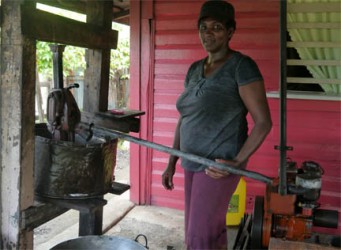
In 2009, then Minister of Agriculture, Robert Persaud had also made efforts to revive the coconut industry.
Persaud had spoken about government’s intention to reverse the inadequate attention given to the sub-sector. He had said that the decline of the local coconut business was due in part to a global decline of the industry, inadequate infrastructure and little work done on research and development.
Figures presented by the Ministry at Monday’s conference showed that the export of unprocessed coconuts was growing whereas the industry needed to add value to the coconut right here. In the case cited above, it was likely that the middleman who was buying from Richmond was exporting the coconuts.
Processing oil
Richmond explained to this newspaper the process of making the oil even as he hustled to meet the target the middleman was looking for.
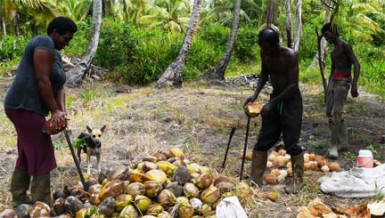
After picking coconuts with a long rod he would peel them on the farm and take them to his home a short distance away. There, he would burst them and use a “digger” to remove the ‘meat.’ This would be grated with a large mechanical grater, powered by a “Lister engine” and then goes into a mashing box. “Clean water would then be poured into it and the fat (milk) would be squeezed out.”
The milk would be set aside in a barrel for a few hours until the water settles at the bottom. The fat would then be skimmed off and put to boil.
After going through a “straining process to separate the oil from the ‘chanche’ [husk that settles at the bottom], the coconut oil would be bottled and ready for the market.
Meanwhile, Trudy gladly took this newspaper to their home where she demonstrated how the processing takes place.
They would use the by-products [the remains from the processing] to feed their goats and would also sell to farmers in the area at $500 per pail. They also use the branches to make brooms to sell.
Persons would purchase the oil mostly to apply to their hair and skin.
Copra
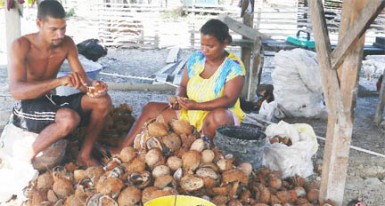
Seeranie ‘Momso’ Chan of the same village would also make brooms to sell but in a larger quantity.
Her husband prefers to sell the coconuts to a middleman and use the rejected ones to make copra, instead of the oil.
They would supply this to a businessman from the East Coast, whose trucks would pick up from them and other farmers from various areas.
Chan said the copra processing is very simple and that her husband and grandson would “burst the coconuts and dig out” the kernel from the shell to dry in the sun. It would form the copra after three days of intense heat.
Over at Airy Hall, Mahaicony, Rohit Mohamed who purchases coconuts from farmers to make oil and copra complained about the dwindling business.
At first he produced 100 gallons of oil per week but said “the business is slow now so I just do a small amount.” Mohamed supplied a quantity of the oil to a businessman last year but he still has not received his full payment.
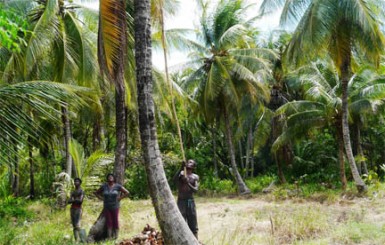
When the business was feasible, he supplied to vendors at Bourda market, on the Corentyne, New Amsterdam and other places.
At the moment he just makes the commodity one time per week just to supply to a shop owner in the area. He also uses the squeezed out coconut to feed his pigs and other livestock. He purchases the nuts from farmers and would sometimes have to do the “picking and the peeling myself.”
When Stabroek News visited he had already supplied the nuts to a businessman for exporting. He was very happy when he learnt that efforts were underway to revive the industry because “I don’t like to work with anyone…”
His father and uncles who “were big in the [oil] business” were forced to quit a few years ago because it was no longer feasible for them.
Eighty-one-year-old Ganga Singh of Washington, West Coast Berbice and his wife, Bhagwandai were sitting on their veranda overlooking their sprawling 250-acre coconut estate.
From their comfort zone they were also monitoring a middleman as he bagged off coconuts in his yard to distribute to exporters. The man would pick and peel the coconuts and would pay Singh a price of $10 each.
Singh, with the assistance of a worker would grate the coconuts to make a small amount of “pure coconut oil” for personal use. He emphasized that it was pure because he does not add “lime and salt to it like some people…”
The man and his wife would apply only the oil to their hair and skin instead of using “expensive cream.”
Bhagwandai told this newspaper that she would normally visit the doctor monthly for treatment for her knee pain but she was not getting much relief.
She decided to stop going and started to massage her knees with the oil and was very happy at the results.
Singh said he was advised to apply the oil to his instep so that it would “penetrate the body and provide cure.”
He told this newspaper that a man whose wife had just given birth went to his home to look for coconut oil to use on the baby. The young couple had found that products like Johnson’s baby oil were causing the infant to have an allergic reaction.
Singh was first engaged in only producing copra to sell until the export market for coconuts started a few years ago.
Coconut oil miracle
In the book: The Coconut Oil Miracle, written by Bruce Fife and published in 2004, it was said that, “Not all saturated fats are unhealthy. In fact, there is a subgroup of saturated fats that actually have a positive effect on your health.”
Fife, a certified nutritionist and director of the Coconut Research Centre said too in the book that, “Unlike other fats, coconut oil protects against heart disease, cancer, diabetes and a host of other degenerative illnesses. It supports and strengthens the immune system, thus helping the body to ward off attack from infection and disease.”
It was also mentioned that coconut oil is unique among oils in promoting weight loss and has earned the reputation of being “the world’s only low-calorie fat.”









